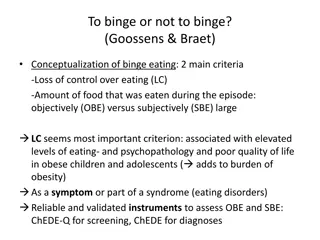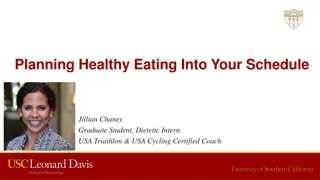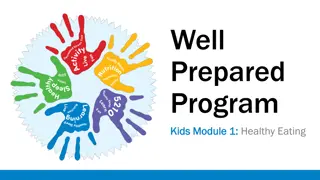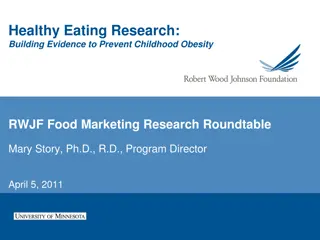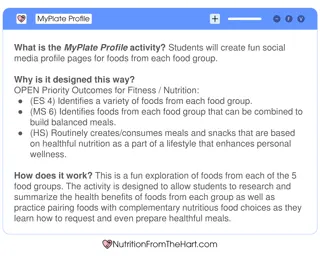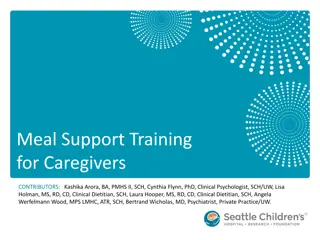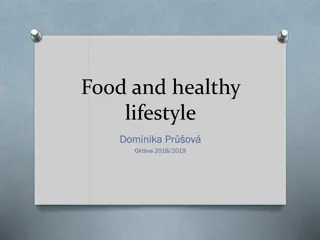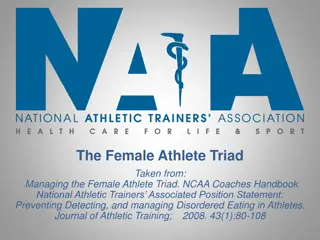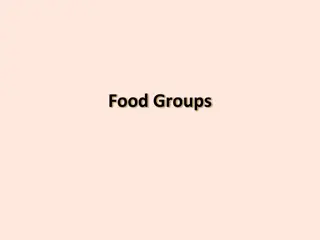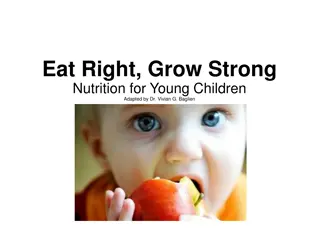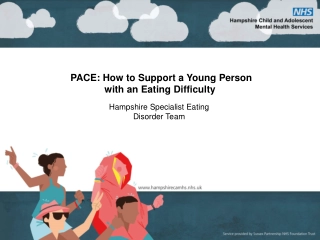Mastering Healthy Eating with MyPlate from ChairmansAcademy.com
Explore the MyPlate module by ChairmansAcademy.com to build a healthy eating style focused on variety, nutrition, and balanced portions. Learn how to make mindful food and beverage choices from different food groups to meet your individual needs and improve overall health. Discover tips for reducing saturated fat, sodium, and added sugars in your diet to manage weight and lower the risk of diseases like heart disease, diabetes, and cancer.
Download Presentation

Please find below an Image/Link to download the presentation.
The content on the website is provided AS IS for your information and personal use only. It may not be sold, licensed, or shared on other websites without obtaining consent from the author. Download presentation by click this link. If you encounter any issues during the download, it is possible that the publisher has removed the file from their server.
E N D
Presentation Transcript
Learning at Your Fingertips Nutrition 1.0 ChairmansAcademy.com ChairmansAcademy.com
In this module: MyPlate Build a healthy eating style Fruits Vegetables Grains Protein foods Dairy Oils ChairmansAcademy.com ChairmansAcademy.com
MyPlate MyPlate is a reminder to find your healthy eating style and build it throughout your lifetime. Everything you eat and drink matters. The right mix can help you be healthier now and in the future. This means: Focus on variety, amount, and nutrition. Choose foods and beverages with less saturated fat, sodium, and added sugars. Start with small changes to build healthier eating styles. Support healthy eating for everyone. ChairmansAcademy.com ChairmansAcademy.com
MyPlate Eating healthy is a journey shaped by many factors, including our stage of life, situations, preferences, access to food, culture, traditions, and the personal decisions we make over time. All your food and beverage choices count. MyPlate offers ideas and tips to help you create a healthier eating style that meets your individual needs and improves your health. ChairmansAcademy.com ChairmansAcademy.com
MyPlate ChairmansAcademy.com ChairmansAcademy.com
Build a healthy eating style All food and beverage choices matter focus on variety, amount, and nutrition. Focus on making healthy food and beverage choices from all five food groups including fruits, vegetables, grains, protein foods, and dairy to get the nutrients you need. Eat the right amount of calories for you based on your age, sex, height, weight, and physical activity level. Building a healthier eating style can help you avoid overweight and obesity and reduce your risk of diseases such as heart disease, diabetes, and cancer. ChairmansAcademy.com ChairmansAcademy.com
Build a healthy eating style Choose an eating style low in saturated fat, sodium, and added sugars. Use Nutrition Facts labels and ingredient lists to find amounts of saturated fat, sodium, and added sugars in the foods and beverages you choose. Look for food and drink choices that are lower in saturated fat, sodium, and added sugar. Eating fewer calories from foods high in saturated fat and added sugars can help you manage your calories and prevent overweight and obesity. Most of us eat too many foods that are high in saturated fat and added sugar. Eating foods with less sodium can reduce your risk of high blood pressure. ChairmansAcademy.com ChairmansAcademy.com
Build a healthy eating style Make small changes to create a healthier eating style. Think of each change as a personal win on your path to living healthier. Each MyWin is a change you make to build your healthy eating style. Find little victories that fit into your lifestyle and celebrate as a MyWin! Start with a few of these small changes. Make half your plate fruits and vegetables. Focus on whole fruits. Vary your veggies. Make half your grains whole grains. Move to low-fat and fat-free dairy. Vary your protein routine. Eat and drink the right amount for you. ChairmansAcademy.com ChairmansAcademy.com
Build a healthy eating style Support healthy eating for everyone. Create settings where healthy choices are available and affordable to you and others in your community. Professionals, policymakers, partners, industry, families, and individuals can help others in their journey to make healthy eating a part of their lives. ChairmansAcademy.com ChairmansAcademy.com
Fruits What foods are in the Fruit Group? Any fruit or 100% fruit juice counts as part of the Fruit Group. Fruits may be fresh, canned, frozen, or dried, and may be whole, cut-up, or pureed. What foods are in the Fruit Group? Any fruit or 100% fruit juice counts as part of the Fruit Group. Fruits may be fresh, canned, frozen, or dried, and may be whole, cut-up, or pureed. ChairmansAcademy.com ChairmansAcademy.com
Fruits What foods are in the Fruit Group? Any fruit or 100% fruit juice counts as part of the Fruit Group. Fruits may be fresh, canned, frozen, or dried, and may be whole, cut-up, or pureed. Why is it important to eat fruit? Eating fruit provides health benefits people who eat more fruits and vegetables as part of an overall healthy diet are likely to have a reduced risk of some chronic diseases. Fruits provide nutrients vital for health and maintenance of your body. ChairmansAcademy.com ChairmansAcademy.com
Fruits What foods are in the Fruit Group? Any fruit or 100% fruit juice counts as part of the Fruit Group. Fruits may be fresh, canned, frozen, or dried, and may be whole, cut-up, or pureed. How much fruit is needed daily? The amount of fruit you need to eat depends on age, sex, and level of physical activity. Recommended daily amounts are shown in the table on the next slide. ChairmansAcademy.com ChairmansAcademy.com
Fruits Daily Recommended Fruit Table Children 2-3 years 4-8 years 1 cup 1 cups Girls 9-13 years 14-18 years 1 cups 1 cups Boys 9-13 years 14-18 years 1 cups 2 cups Women 19-30 years 31-50 years 51 + years 2 cups 1 cups 1 cups Men 19-30 years 31-50 years 51 + years 2 cups 2 cups 2 cups ChairmansAcademy.com ChairmansAcademy.com
Fruits The amounts on the previous table are appropriate for individuals who get less than 30 minutes per day of moderate physical activity, beyond normal daily activities. Those who are more physically active may be able to consume more while staying within calorie needs. ChairmansAcademy.com ChairmansAcademy.com
Fruits What counts as a cup of fruits? In general, 1 cup of fruit or 100% fruit juice, or cup of dried fruit can be considered as 1 cup from the Fruit Group. ChairmansAcademy.com ChairmansAcademy.com
Vegetables What foods are in the Vegetable Group? Any vegetable or 100% vegetable juice counts as a member of the Vegetable Group. Vegetables may be raw or cooked; fresh, frozen, canned, or dried/dehydrated; and may be whole, cut-up, or mashed. Based on their nutrient content, vegetables are organized into 5 subgroups: dark-green vegetables, starchy vegetables, red and orange vegetables, beans and peas, and other vegetables. ChairmansAcademy.com ChairmansAcademy.com
Vegetables Why is it important to eat vegetables? Eating vegetables provides health benefits people who eat more vegetables and fruits as part of an overall healthy diet are likely to have a reduced risk of some chronic diseases. Vegetables provide nutrients vital for health and maintenance of your body. ChairmansAcademy.com ChairmansAcademy.com
Vegetables How many vegetables are needed? The amount of vegetables you need to eat depends on your age, sex, and level of physical activity. Recommended total daily amounts are shown on the next slide. ChairmansAcademy.com ChairmansAcademy.com
Vegetables Daily Recommended Vegetable Table Children 2-3 years 4-8 years 1 cup 1 cups Girls 9-13 years 14-18 years 2 cups 2 cups Boys 9-13 years 14-18 years 2 cups 3 cups Women 19-30 years 31-50 years 51 + years 2 cups 2 cups 2 cups Men 19-30 years 31-50 years 51 + years 3 cups 3 cups 2 cups ChairmansAcademy.com ChairmansAcademy.com
Vegetables What counts as a cup of vegetables? In general, 1 cup of raw or cooked vegetables or vegetable juice, or 2 cups of raw leafy greens can be considered as 1 cup from the Vegetable Group. ChairmansAcademy.com ChairmansAcademy.com
Grains What foods are in the Grain Group? Any food made from wheat, rice, oats, cornmeal, barley or another cereal grain is a grain product. Bread, pasta, oatmeal, breakfast cereals, tortillas, and grits are examples of grain products. ChairmansAcademy.com ChairmansAcademy.com
Grains Why is it important to eat grains, especially whole grains? Eating grains, especially whole grains, provides health benefits. People who eat whole grains as part of a healthy diet have a reduced risk of some chronic diseases. Grains provide many nutrients that are vital for the health and maintenance of our bodies. ChairmansAcademy.com ChairmansAcademy.com
Grains Grains are divided into 2 subgroups, Whole Grains and Refined Grains. Whole grains contain the entire grain kernel the bran, germ, and endosperm. Examples of whole grains include whole-wheat flour, bulgur (cracked wheat), oatmeal, whole cornmeal, and brown rice. ChairmansAcademy.com ChairmansAcademy.com
Grains Refined grains have been milled, a process that removes the bran and germ. This is done to give grains a finer texture and improve their shelf life, but it also removes dietary fiber, iron, and many B vitamins. Some examples of refined grain products are white flour, de- germed cornmeal, white bread, and white rice. ChairmansAcademy.com ChairmansAcademy.com
Grains Most refined grains are enriched. This means certain B vitamins (thiamin, riboflavin, niacin, folic acid) and iron are added back after processing. Fiber is not added back to enriched grains. Check the ingredient list on refined grain products to make sure that the word "enriched" is included in the grain name. Some food products are made from mixtures of whole grains and refined grains. ChairmansAcademy.com ChairmansAcademy.com
Grains How many grain foods are needed daily? The amount of grains you need to eat depends on your age, sex, and level of physical activity. Recommended daily amounts are listed in this table below. Most Americans consume enough grains, but few are whole grains. At least half of all the grains eaten should be whole grains. ChairmansAcademy.com ChairmansAcademy.com
Daily Grain Table Grains Daily Recommended Daily min. amount of whole grains Children 2-3 years 4-8 years 3 oz. 5 oz. 1 oz. 2 oz. Girls 9-13 years 14-18 years 5 oz. 6 oz. 3 oz. 3 oz. Boys 9-13 years 14-18 years 6 oz. 8 oz. 3 oz. 4 oz. Women 19-30 years 31-50 years 51 + years 6 oz. 6 oz. 5 oz. 3 oz. 3 oz. 3 oz. Men 19-30 years 31-50 years 51 + years 8 oz. 7 oz. 6 oz. 4 oz. 3 oz. 3 oz. ChairmansAcademy.com ChairmansAcademy.com
Grains What counts as an ounce-equivalent of grains? In general, 1 slice of bread, 1 cup of ready-to- eat cereal, or cup of cooked rice, cooked pasta, or cooked cereal can be considered as 1 ounce-equivalent from the Grains Group. ChairmansAcademy.com ChairmansAcademy.com
Proteins What foods are in the Protein Group? All foods made from meat, poultry, seafood, beans and peas, eggs, processed soy products, nuts, and seeds are considered part of the Protein Foods Group. Beans and peas are also part of the Vegetable Group. For more information on beans and peas, see Beans and Peas Are Unique Foods. ChairmansAcademy.com ChairmansAcademy.com
Proteins What foods are in the protein group? Select a variety of protein foods to improve nutrient intake and health benefits, including at least 8 ounces of cooked seafood per week. Young children need less, depending on their age and calorie needs. The advice to consume seafood does not apply to vegetarians. Vegetarian options in the Protein Foods Group include beans and peas, processed soy products, and nuts and seeds. Meat and poultry choices should be lean or low-fat. ChairmansAcademy.com ChairmansAcademy.com
Proteins Why is it important to make lean or low-fat choices from the Protein Foods Group? Foods in the meat, poultry, fish, eggs, nuts, and seed group provide nutrients that are vital for health and maintenance of your body. However, choosing foods from this group that are high in saturated fat and cholesterol may have health implications. ChairmansAcademy.com ChairmansAcademy.com
Proteins How much food from the Protein Foods Group is daily? The amount of food from the Protein Foods Group you need to eat depends on age, sex, and level of physical activity. Most Americans eat enough food from this group, but need to make leaner and more varied selections of these foods. Recommended daily amounts are shown in the table on the next slide. ChairmansAcademy.com ChairmansAcademy.com
Proteins Daily Protein Foods Table Children 2-3 years 4-8 years 2 oz. 4oz. Girls 9-13 years 14-18 years 5 oz. 5oz. Boys 9-13 years 14-18 years 5 oz. 6 oz. Women 19-30 years 31-50 years 51 + years 5 oz. 5 oz. 5 oz. Men 19-30 years 31-50 years 51 + years 6 oz. 6 oz. 5 oz. ChairmansAcademy.com ChairmansAcademy.com
Proteins What counts as an ounce-equivalent in the Protein Foods Group? In general, 1 ounce of meat, poultry or fish, cup cooked beans, 1 egg, 1 tablespoon of peanut butter, or ounce of nuts or seeds can be considered as 1 ounce-equivalent from the Protein Foods Group. ChairmansAcademy.com ChairmansAcademy.com
Proteins Selection Tips Choose lean or low-fat meat and poultry. If higher fat choices are made, such as regular ground beef (75-80% lean) or chicken with skin, the fat counts against your maximum limit for empty calories (calories from solid fats or added sugars). If solid fat is added in cooking, such as frying chicken in shortening or frying eggs in butter or stick margarine, this also counts against your maximum limit for empty calories (calories from solid fats and added sugars). ChairmansAcademy.com ChairmansAcademy.com
Proteins Selection Tips (cont.) Select some seafood that is rich in omega-3 fatty acids, such as salmon, trout, sardines, anchovies, herring, Pacific oysters, and Atlantic and Pacific mackerel. Processed meats such as ham, sausage, frankfurters, and luncheon or deli meats have added sodium. Check the Nutrition Facts label to help limit sodium intake. Fresh chicken, turkey, and pork that have been enhanced with a salt-containing solution also have added sodium. Check the product label for statements such as self-basting or contains up to __% of __ , which mean that a sodium- containing solution has been added to the product. Choose unsalted nuts and seeds to keep sodium intake low. ChairmansAcademy.com ChairmansAcademy.com
Dairy What foods are included in the Dairy Group? All fluid milk products and many foods made from milk are considered part of this food group. Most Dairy Group choices should be fat- free or low-fat. ChairmansAcademy.com ChairmansAcademy.com
Dairy Why is it important to make fat-free or low- fat choices from the Dairy Group? Choosing foods from the Dairy Group that are high in saturated fats and cholesterol can have health implications. Diets high in saturated fats raise "bad" cholesterol levels in the blood. The "bad" cholesterol is called LDL (low-density lipoprotein) cholesterol. High LDL cholesterol, in turn, increases the risk for coronary heart disease. ChairmansAcademy.com ChairmansAcademy.com
Dairy Why is it important to make fat-free or low- fat choices from the Dairy Group? Many cheeses, whole milk, and products made from them are high in saturated fat. To help keep blood cholesterol levels healthy, limit the amount of these foods you eat. In addition, a high intake of fats makes it difficult to avoid consuming more calories than are needed. ChairmansAcademy.com ChairmansAcademy.com
Dairy Nutrients and health benefits Consuming dairy products provides health benefits especially improved bone health. Foods in the Dairy Group provide nutrients that are vital for health and maintenance of your body. These nutrients include calcium, potassium, vitamin D, and protein. ChairmansAcademy.com ChairmansAcademy.com
Dairy What foods are included in the Dairy Group? Foods made from milk that retain their calcium content are part of the group. Foods made from milk that have little to no calcium, such as cream cheese, cream, and butter, are not. Calcium-fortified soymilk (soy beverage) is also part of the Dairy Group. ChairmansAcademy.com ChairmansAcademy.com
Dairy What foods are included in the Dairy Group? Foods made from milk that retain their calcium content are part of the group. Foods made from milk that have little to no calcium, such as cream cheese, cream, and butter, are not. Calcium-fortified soymilk (soy beverage) is also part of the Dairy Group. ChairmansAcademy.com ChairmansAcademy.com
Dairy How much food from the Dairy Group is needed daily? The amount of food from the Dairy Group you need to eat depends on age. Recommended daily amounts are shown in the table on the next slide. ChairmansAcademy.com ChairmansAcademy.com
Dairy Daily Dairy Table Children 2-3 years 4-8 years 2 cups 2 cups Girls 9-13 years 14-18 years 3 cups 3 cups Boys 9-13 years 14-18 years 3 cups 3 cups Women 19-30 years 31-50 years 51 + years 3 cups 3 cups 3 cups Men 19-30 years 31-50 years 51 + years 3 cups 3 cups 3 cups ChairmansAcademy.com ChairmansAcademy.com
Dairy What counts as a cup in the Dairy Group? In general, 1 cup of milk, yogurt, or soymilk (soy beverage), 1 ounces of natural cheese, or 2 ounces of processed cheese can be considered as 1 cup from the Dairy Group. ChairmansAcademy.com ChairmansAcademy.com
Dairy For those who choose not to consume milk products Calcium choices for those who do not consume dairy products include: Calcium-fortified juices, cereals, breads, rice milk, or almond milk. Canned fish (sardines, salmon with bones) soybeans and other soy products (tofu made with calcium sulfate, soy yogurt, tempeh), some other beans, and some leafy greens (collard and turnip greens, kale, bok choy). The amount of calcium that can be absorbed from these foods varies. ChairmansAcademy.com ChairmansAcademy.com
Oils What are "oils"? Oils are fats that are liquid at room temperature, like the vegetable oils used in cooking. Oils come from many different plants and from fish. Oils are NOT a food group, but they provide essential nutrients. Therefore, oils are included in USDA food patterns. ChairmansAcademy.com ChairmansAcademy.com
Oils What are "oils"? Some commonly eaten oils include: canola oil, corn oil, cottonseed oil, olive oil, safflower oil, soybean oil, and sunflower oil. Some oils are used mainly as flavorings, such as walnut oil and sesame oil. A number of foods are naturally high in oils, like nuts, olives, some fish, and avocados. ChairmansAcademy.com ChairmansAcademy.com
Oils What are "oils"? Foods that are mainly oil include mayonnaise, certain salad dressings, and soft (tub or squeeze) margarine with no trans fats. Check the Nutrition Facts label to find margarines with 0 grams of trans fat. Amounts of trans fat are required to be listed on labels. ChairmansAcademy.com ChairmansAcademy.com
Oils What are "oils"? Most oils are high in monounsaturated or polyunsaturated fats, and low in saturated fats. Oils from plant sources (vegetable and nut oils) do not contain any cholesterol. In fact, no plant foods contain cholesterol. A few plant oils, however, including coconut oil, palm oil, and palm kernel oil, are high in saturated fats and for nutritional purposes should be considered to be solid fats. ChairmansAcademy.com ChairmansAcademy.com


